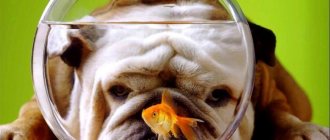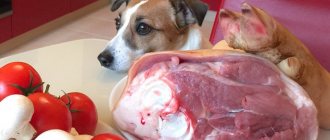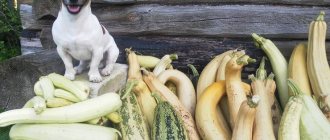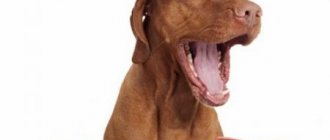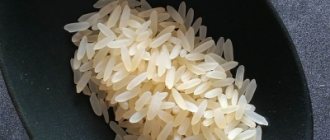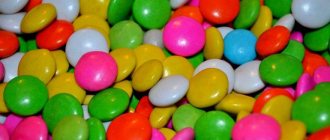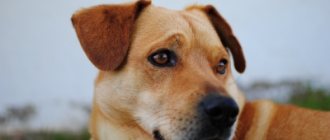Can dogs be given raw meat? The answer to this question is very controversial. There are as many supporters of such a feeding system as there are opponents. Arguments claiming that unprocessed meat has undoubted benefits sound very convincing. As well as those who say that raw meat is potentially harmful to a pet’s health. To understand which meat better satisfies the need for nutritious food, and to properly organize balanced feeding for your pet, you need to understand the basic physiology of the dog’s body.
The benefits and harms of meat for dogs
Meat should make up the majority of a dog's diet. From it the animal receives the maximum of substances necessary for life, which contribute to:
- replenishing the body with energy;
- strengthening the skeleton;
- building muscle mass;
- stable functioning of the hematopoietic system;
- improving the quality of coat and skin condition;
- general strengthening of the immune system.
Expert opinion
Kuzmenko Olga Olegovna
Information about the expert
Ask a Question
You should choose pulp of low-fat varieties. The fatty product is difficult to digest and stimulates the occurrence of diseases of the digestive system.
The benefits of different types of meat
- Pork. Not recommended for feeding puppies and pet dogs prone to obesity. Its lean parts are suitable for large breeds kept in open-type enclosures. The best time for such complementary feeding is winter, when serious energy replenishment is required.
- Beef. The best solution for the animal in terms of benefit and cost. Rich in organic iron, it does not cause allergic reactions. And its fat maintains energy balance in the body. It is best to start feeding puppies with this meat. Moreover, mature beef contains significantly more useful substances than young veal.
- Chicken. A controversial product because it often causes allergies. At the same time, it is a source of easily digestible protein.
- Rabbit meat. An excellent source of highly digestible protein. Allergies from its use occur extremely rarely. Used when necessary for dietary nutrition.
- Horse meat and lamb. Low-fat product that does not cause allergies. Rich in B vitamins. Better absorbed than beef.
- Offal. They cannot replace meat in terms of nutritional value, but they also have valuable properties. For example, beef tripe contains iron, phosphorus, and zinc. In its raw form, it retains particles of digestive enzymes. They help the dog's intestines cope with plant fiber. And the liver contains iron and folic acid, which is important for the body. Its deficiency results in pregnancy pathologies, inflammation of the mucous membranes and anemia.
Possible harm from meat products
Despite the benefits of meat, it also has negative effects:
- Any raw product can become a source of infection. You cannot feed the carcasses of dead animals, because the cause of death is not hunger or old age, but infectious diseases.
- Kidneys and liver require special preparation before use. They accumulate many toxins, naturally cleansing the animal’s body. They must be soaked and then scalded with boiling water.
- Chicken often contains growth hormones and all sorts of dietary supplements. Therefore, it can cause allergies in dogs. It can also become a source of salmonella infection.
- The flesh of wild animals can contain worm eggs and viruses of severe infections. It can only be fed boiled.
Individual reaction
Allergies to food are a very common phenomenon, which is not the least important among other allergic reactions that occur in animals. It is important to be able to distinguish food allergies from intolerance to certain types of foods.
Food allergies are not uncommon in dogs.
Individual intolerance is accompanied by diarrhea, nausea or vomiting without other symptoms characteristic of allergies.
To determine the allergen, conduct an experiment. At the first manifestation of a reaction, put your pet on a strict diet excluding all foods that may cause allergies. Typically, this meal consists of several ingredients, such as rice and lamb. Apart from these products, do not add anything, because a reaction to the allergen can appear even a month after its consumption.
This is interesting! Mix of Spitz and Yorkie: description, pomchi standard.
Stick to this diet for at least 3 weeks, and then gradually introduce one product and watch the reaction.
A couple of weeks after the strict regime, offer your pet fermented milk products, but do it very carefully. It is best to choose biokefir, bifidum-ryazhenka, etc.
Naturally, it takes a lot of time to determine the allergen and safe products. If you cannot cope with the problem on your own, contact your veterinarian.
Author Admin .6k. Updated 07/23/2020
Pomeranians are an absolutely picky breed when it comes to food. They will eat whatever they are taught to eat from childhood. The owner chooses what to feed the Spitz himself. You can turn your pet into a picky eater by spoiling him with a wide variety of foods. Or accustom him to a certain diet, which he will get used to and eat with pleasure.
Is it possible to give your dog raw meat?
Which meat is better to give your dog raw or cooked? When asking this question, remember that your pet is a predator. It has been proven that:
- The fresh product contains a full range of substances important for the body.
- It is absorbed better because the dog’s digestive tract is adapted to digest raw fiber, like that of any predator.
- The body becomes satiated faster, and the portion size required is smaller.
- During the cooking process, meat decreases in volume, most of the nutrients are destroyed or remain in the water. But the broth itself does not have the same value for a dog as it does for a person.
Product purchased from official markets and stores is considered safe. It undergoes mandatory veterinary and sanitary control. If its freshness is not suspicious, you can safely feed it to your dog without heat treatment.
If a hunting dog goes outdoors with its owner, strictly prohibit it from eating wild animals. They can be infected with parasites and dangerous diseases.
To prevent the development of mastitis in a puppy, it is not recommended to feed raw meat in the first week after birth. Such foods can cause increased lactation. Newborn puppies are too weak to handle large volumes of milk.
From three weeks of age, you can give your dog raw meat, which is scraped frozen. It is served as a separate dish or mixed with porridge.
What you should absolutely not feed your pet
The list of prohibited foods for dogs is extensive. Of course, if your pet accidentally swallows a piece of food that is not allowed, nothing bad will happen. But if you feed your dog this way constantly or in large quantities, his health will certainly deteriorate.
The most dangerous food
A number of products lead to serious consequences. The owners know about them, but some stubbornly ignore the prohibitions and continue to give “goodies”. Such foods include:
- Spicy, smoked, marinated, seasoned, salty dishes, sausages. The abundance of salt and fat provokes inflammation of the pancreas, liver, volvulus, obesity, disrupts the water-salt balance, the functioning of the liver, joints, and increases blood pressure.
- Chocolate. Contains theobromine, which leads to poisoning, convulsions, arrhythmia, and in large quantities – death.
- Alcohol. It threatens with intoxication, heart failure, paralysis of the nervous system, and death.
- Sweet. Destroys teeth, leads to diabetes, obesity, and gastrointestinal disorders.
- Yeast dough products. They cause fermentation, lead to painful colic, and occasionally to rupture of the intestinal walls.
- Coffee and tea. Caffeine in drinks is harmful to the heart, nervous system, and disrupts the functioning of the digestive system.
Animal products
Dogs are predators and meat eaters. But not all meat is equally healthy. So, animals cannot be fed:
- Fish, chicken, tubular bones. The fragments damage the digestive tract, can get stuck between the teeth, in the throat, and lead to suffocation.
- Raw river fish. Risk of infection with helminths, injury from small bones.
- Milk. Absorbed only by puppies, it causes diarrhea in adult pets.
- Raw chicken eggs. The enzyme avidin inhibits the synthesis and absorption of vitamin B1, which leads to skin and coat diseases. Salmonella infection is also possible.
Plant food
Vegetables, fruits, berries, and cereals supply the pets’ body with vitamins; without them, normal functioning of the digestive organs is impossible. However, a number of plant products are dangerous for dogs.
Prohibited fruits and vegetables:
- Peaches, persimmons, plums. Lead to intestinal obstruction.
- Grapes, raisins, currants. Causes kidney failure. Although some dogs, regardless of breed, tolerate berries well, it’s not worth the risk.
- Citrus fruits, kiwi, pineapples. Lead to allergies and stomach inflammation.
- Avocado. The poisonous element persin leads to intoxication.
- Raw cabbage. Provokes increased gas formation.
- Potatoes – raw, boiled, fried. Contains a lot of easily digestible carbohydrates, starch and solanine, which are harmful to the pet's body.
- Broccoli. Toxic in large quantities due to isocyanate.
- Onion and garlic. The presence of thiosulfates provokes anemia.
- Fruit and pomegranate seeds. Causes intestinal obstruction and contains cyanide, which is poisonous to dogs.
Harmful grains, greens and more:
- Legumes. They are poorly digested and absorbed, leading to flatulence.
- Corn. An allergen that causes stomach upset, damages teeth, and increases blood sugar levels.
- Sorrel and rhubarb. Due to oxalates, the functioning of the urinary system is disrupted.
- Spinach. Contains a toxic substance, oxalate, which is harmful in large quantities.
- Hop. Provokes shortness of breath, convulsions, fever and increased heart rate.
- Porridges made from corn, wheat, semolina, pearl barley. They are poorly absorbed and digested, causing bloating.
- Mushrooms. There is a high probability of poisoning; they contain chitin, which is harmful to the liver and pancreas.
- Nuts. They are not absorbed by canines and disrupt the functioning of the gastrointestinal tract.
The list of foods that should not be given to dogs will be useful not only for adherents of natural food, but also for those who feed their dogs industrial food. If the composition contains one of the above ingredients, you should not purchase the product.
Briefly about the main thing
- The dog is a carnivore, its digestive system is prepared by nature to feed on raw meat;
- The animal's menu can consist of both raw and cooked products;
- Cheese contains more protein, fat and carbohydrates. A smaller portion is required for complete saturation;
- You can use different types of meat products, observing the reaction of the animal’s body;
- Chicken and other birds are given boiled;
- Treat your pet to offal and raw tripe twice a week;
- The meat is cut into pieces, the bones are given only raw.
Is it possible to mix
You can often hear that it is not recommended to change dry food throughout life and not to mix dry food with regular (natural) food. However, many breeders believe that alternating food from natural products with industrial food is acceptable. It’s just important not to mix them into one feeding. It is a mistake to believe that a mixture of porridge and croquettes will give the dog more benefits and fill it up faster.
You can mix wet food with kibble from the same manufacturer. However, there is a drawback - this significantly increases the cost of feeding.
There are canned foods into which it is permissible to add boiled cereals, usually rice porridge or buckwheat. It's written on the cans.
If your pet doesn’t eat one food well, you have to switch to another. This is done gradually. The digestive system does not adapt immediately. It will take several days. On average, the translation process takes a week.
How to give a raw product correctly to avoid trouble?
For the safety of your pet, you must adhere to the following rules:
- Raw meat should be scalded with boiling water before feeding. To improve the effect, it is recommended to chop it. Even if you bought it from a trusted place, you cannot exclude the possibility of pathogenic bacteria entering during transportation and storage. This serving method will also help if the dog refuses raw meat in its pure form.
- To kill possible parasites, it is enough to freeze it. Pre-divide into portions for easy use later. It is better to defrost in the refrigerator; you cannot use a microwave for this purpose.
- When on a raw food diet, carefully monitor your dog's health. Allergies, diarrhea, or parasite infection may occur.
- The bird carcass must be freed from bones. They can cause surgery or constipation, at best.
- Choose only low-fat cuts. Along with the muscle parts, a sufficient amount of healthy fat enters the pet’s body. Excess causes diarrhea, allergies and excessive stress on the kidneys and liver.
- You can’t feed meat with a “smell.” A spoiled product may be sold at a reduced price, but you should not skimp on your pet’s health.
Useful video on the topic: is it possible to give raw meat to a dog?
Feed additives
When feeding dry food, it is not recommended to give additional multivitamins. In feed they are contained in concentrated form to prevent their loss during storage. Therefore, excessive doses of vitamins can be dangerous.
Additional supplements can only be prescribed by a veterinarian if the dog is sick, pregnant or raising puppies.
Food additives are a common cause of allergies. They should be given after consultation with a veterinarian.
Most often, Spitz dogs are given brewer's yeast, as it stimulates coat growth.
Red and brown dogs are fed seaweed. It is believed that it deepens the color of the coat.
Sea kale is not recommended for representatives of the wolf-colored breed, since the yellowish color of the coat is not welcome in this species.
Spitz breeds do not need mineral supplements as much as large breeds. They get everything they need from food. An excess of calcium disrupts the metabolism of minerals, which affects the condition of the teeth: baby teeth become very strong, so they do not allow permanent teeth to grow.
If the owner notes such a picture - the dog is licking the tiles, trying to gnaw on the walls, then he probably needs mineral supplements, which should be chosen in consultation with a veterinarian.
Daily ration
Meat should account for an average of 30-40% of the total food that the animal eats daily. When calculating the required amount, you should take into account the breed, gender, weight, temperament and lifestyle of the pet.
So, if a dog lives in an apartment and doesn’t run around much, 10-20 grams of meat per day per kilogram of weight may be enough for him. An active, energetic, athletic young dog or working animal (hunter, rescuer, etc.) needs more - up to 30 grams of meat per day per kilogram of its weight.
The norms for growing puppies have been increased, because they need a lot of microelements to form all body systems. In addition, at the age of about a year, most dogs are especially active and mobile, which means they need a complete protein diet.
The table below shows approximate values for pets of different breeds (in kilograms per day).
| Breeds | Puppy 6-12 months | Adult dog | Older dog (over 8 years old) |
| Small (an adult dog weighs less than 10 kg) | 0,5-1 | 0,4-0,8 | 0,3-0,8 |
| Medium (an adult dog weighs 10-25 kg) | 1-2 | 0,8-1,5 | 0,6-1 |
| Large (an adult animal weighs more than 25 kg) | 1,5-2,5 | 1-2 | 0,8-1,5 |
You can use the following formula for calculations: X * 2/100, where X is the weight of the dog. For example, if a dog weighs 30 kg, multiply this number by two, divide by one hundred and get 0.6 kg of meat per day.
The norm should be increased for a very active dog, for a weakened dog (for example, after an illness) or when fighting obesity (the number of fats and carbohydrates decreases, the percentage of proteins - meat increases). Then the formula will look like this: X*3/100. For example, if the dog weighs the same 30 kg, multiply by three, divide by one hundred and get 0.9 kg per day.
What is sausage made of?
Ham, sausage - “Doctorskaya”, “Lyubitelskaya” or liverwurst, frankfurters or small sausages, carbonate or ham - all these products that are tasty for us should not end up in the pet’s bowl, no matter how he begs for them. Dogs do not need a varied diet, and a sausage sandwich, which many people start their breakfast with, can be dangerous for a pet. It's all about the composition of meat products and semi-finished products.
According to GOST, “Doctor’s” sausage must contain 25% lean pork and beef, 45% lean pork, as well as egg melange and milk powder (2% and 3%, respectively). There are no complaints about these products (or rather, almost none, since pork, especially fatty pork, is not the best food option for a dog). The problem is:
- salt;
- spices;
- starch - in cheap sausage, as quality tests show, it is always present; in expensive sausage, made according to GOST, you can also find traces of it, although they should not be there;
- food additives – coloring and thickener.
For a dog, the appearance - beautiful pink or natural meat - does not matter, but such additives can harm it. And even more so, nitrogen and carbon dioxide, which are pumped into packaging film for additional preservation and preventing the proliferation of microorganisms, are not useful.
A dog needs meat, but inexpensive varieties of sausage (who would feed a pet “Doctorskaya” for 600 rubles/kg?) do not contain beef and pork - they may contain poultry and soy. This is such a “useful” product.
Useful tips
You can feed your dog raw meat, but it is important to follow some rules:
- Cut into large pieces so your dog will have to tear and chew. This process will clean your teeth.
- The portion is calculated based on the age, weight, breed and well-being of the animal. For an apartment dog - 20 g per 1 kg, for an active young pet or a pet weakened by illness - 30 g per 1 kg of weight.
- It is recommended to divide the daily portion into two doses.
- You cannot replace your dog's protein diet with meat. It is also necessary to include low-fat fish and fermented milk products.
- If you don’t want to give the pulp raw, but want to retain more nutrients, cook it at the same time as the cereal. The porridge will quickly cook, and the meat will receive primary heat treatment without losing its beneficial elements.
Conclusion: giving dogs fresh meat is necessary. But do not forget about compliance with the rules and regulations for the safety of its use. Combine a variety of sources of animal protein, add cereals, seasonal vegetables and your pet will always be healthy and active.
Nutrition rules
In order for the animal to be healthy and cheerful, you need to follow certain recommendations on how to feed your dog correctly:
- Always feed your pet after a walk - this is an important rule. As a last resort, he should eat 2 hours before going outside.
- An adult dog is fed at the same time - morning and evening, a puppy - at equal intervals.
- Despite being omnivorous, you should not feed your Spitz human food from the table.
- It is permissible to soak dry food in water for a Spitz puppy, accustoming it to this type of food. This is not done to an adult dog. Dry granules, in addition to satiation, perform another function - when a dog chews them, its jaws work, the blood supply to the teeth improves, and plaque is cleared.
- When feeding a natural diet, it should be taken into account that the quantity and composition of food varies depending on the age of the dog and the time of year. So, in winter a Spitz needs more food than in summer. During the molting period, vitamins and microelements are necessary for beautiful fur.
It happens that animals vomit after eating. If this happens once, about 20-30 minutes after eating, you should not be alarmed - this is the norm.
If the dog does not eat dry food and refuses homemade food, there is no need to force feed it. This is probably a sign of illness and it is best to contact a veterinarian.
What's harmful?
Not everything in the world is equally useful. This axiom is also true for our little brothers. There are products that will not bring any benefit, and often cause great harm, causing, at best, an upset stomach, and at worst, serious diseases of the internal organs.
Unhealthy food:
- Pork . Too fatty and heavy for a dog's digestive system. Their ancestors have never encountered anything like this, which means their stomachs simply cannot digest this type of product and get what they need.
- Lard and pieces with fatty layers will also have an extremely negative effect on the absorption of nutrients.
- All kinds of chemical and vegetable substitutes , for example, soy.
- Sausage, frankfurters, sausages and other store-bought human “delicacies”. The animal eats them with pleasure, but they are made for people, taking into account their preferences. Such products contain salt and spices, which are extremely harmful. Specific processing methods and all kinds of chemical additives will also not add any benefit.
- Prepared for humans . Unless you are an opponent of spices and prefer to cook exclusively by steaming, do not share your dinner with your pet, even if he is actively begging. A piece from your plate will only harm your pet.
- Fried, baked, smoked or otherwise prepared meat is considered “dead” to the dog. The amino acids it needs have been destroyed, and protein will be poorly absorbed. But dried or dried pieces of beef without spices can be given out as a treat.
Dry feeding
When deciding what to feed a Pomeranian, many people choose dry ready-made food. They are also called croquettes.
The advantages of the food are obvious:
- no need to combine diet;
- saving time;
- convenient to store;
- does not require additional minerals and vitamins.
However, what you should not do is feed your pet cheap food. They use vegetable protein, which cannot meet the animal's needs. And soy is a common cause of allergies. Corn is added to cheap drying. The ingredient saturates quickly, but is difficult to digest.
When choosing dry food for your Spitz, you need to pay attention to the following:
- The composition should not contain less than 25% protein. Protein (protein) must be of both animal and plant origin.
- The best dog food definitely contains meat, fish, liver, and protein derived from soy and alfalfa.
- Vitamins are an essential component of dry food. The composition should contain vitamins A, D and group B.
You don't have to worry about carbohydrates and minerals. These are cheap components, so every food for Spitz contains them in sufficient quantities.
These recommendations also apply to the choice of wet food. He eats it with pleasure. However, feeding your dog only canned food is very expensive.
Having decided what food to feed your Spitz, you need to follow the manufacturer's instructions for dosage and number of feedings. Veterinarians do not recommend frequently changing food for Spitz dogs without good reason. This may adversely affect the health of the animal.
For the breed, the best choice is super premium or holistic food. They are more expensive than drying from the supermarket, but the dog will be healthier from them.
The rating of the best premium and super premium food includes the following brands:
- Eucanuba
- Optima Nova
- Iams
- Nutro nuggets
- Pro Pac
- Happy Dog – hypoallergenic food
- Hills – for allergy sufferers
- Golden Eagle – hypoallergenic food
- 1st Choice
- Bosch
Holistic food for Spitz:
- Acana
- Orijen
- Innova
- Canidae
- Grandorf
- Eagle Pack Holistic
- Wellness
- Chicken Soup
Food for the Pomeranian Spitz, as for other varieties of the breed, is better to choose with a veterinarian or breeder.
When feeding dry food, it is imperative that the animal has access to water. It is better to hide the bag of granules. Spitz are gluttons. They may uncontrollably eat large amounts of dry food and harm themselves.
